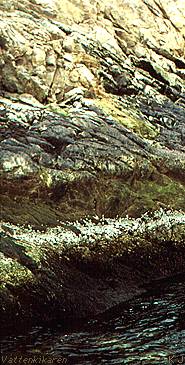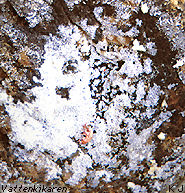
For organisms living in the sea, the underwater environment is usually
quite favourable and relatively constant. Further up the beach, organisms
are exposed to increasing periods where they surrounded by air which
results in increased stress and hardshhip for those creatures that
have chosen to live there. |
Temperature, humidity and
salinity
can vary greatly. During one year, sea water temperatures can vary
from just below 0 °C to about 20 °C, while air temperatures
close to a cliff can vary from about -30 °C to about +30 °C.
Naturally, humidity does not vary in the sea, but on sunny days it
can be so low that unprotected organisms can quickly became dehydrated.
Even salinity can vary greatly along the Swedish coastline, from 0
to about 3,5 % in the water and between 0 and
100 % on the cliffs.

This rock pool has dried out and for the poor little sand
hopper the beach became too warm, dry and salty.
|


